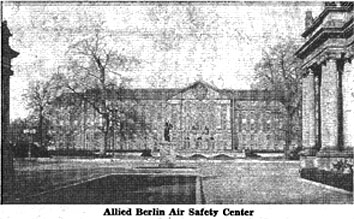|
The borough of Schoeneberg stretches south from the Tiergarten
borough and is bounded on the west by Wilmersdorf, on the east by
Kreuzberg and Tempelhof and on the south by Steglitz.
Schoeneberg, or as it was known in the 13th century, Sconenberch,
was certified by Margrave of Brandenburg, Otto III, in the year 1264.
For more than 630 years Schoeneberg thrived as a wealthy village.
In 1860 the agricultural land was opened up. for building and the population rose from 7,700 to 96,000 in 4O years. Today the borough claims more than 190,000 inhabitants. The name of the borough, comes
from two German words, “schoener” and “Berg” meaning ‘beautiful hill.
Across from the WittenbergpIatz, underneath which lies one of the
main U-Bahn terminals, is the Kaufhaus des Westens, the largest department store in West Berlin. On the east side of the square sprawl the new office blocks’ of the Hertie concern, which owns many department stores in West Germany. Following the Meist Strasse
through the Alter Westen (Old West End) comes upon the Haus der Werbung, a 18O-foot tall structure built on a triangular sight for the advertising firm of Dorland. Atop the building is a beautiful roofgarden cafe.
Further down the Kleist Strasse is the new building-erected in 1962
-of Urania Berlin, a cultural society. It has a lecture hall with a seating capacity of 1,000, smaller study and lecture rooms, exhibition rooms, and various club facilities. The society, founded in 1888, was Berlin’s first institution for popular education and now has 12,500 members. In 1963 and 1964 the club sponsored a program of over 500 events, which were attended by 200,000 persons. The busy Nollendorfplatz was once kriown for the theater of that name, which has been rebuilt and is now a cinema. From here, several blocks down Buelow Strasse and to the
right on Potsdamer Strasse, is the Sportpalast. Of the 1,600 acres of
land devoted to the pursuance of the many sports which West Berliners
enjoy, the Sportpalast is perhaps the most famous arena.
The building was erected in 1910 as indoor ice rink. Since its construction the Sportpalast has out grown its original purpose. It has been used as asports arena, a meeting hall and even concerts have been
performed within its walls; In the winter it becomes a center for the
Bockbier Fest with Bavarian bands, dancing and roasted oxen on a spit.
After 1933, political rallies took place in the huge auditorium. The
building was badly damaged during the war and was not reopened until
October 1951 with a program of ice hockey and skating. The venture was
a financial failure because the roofless Sportpalast was too cold for the
spectators to enjoy the show. After additional reconstruction the
building, complete with a roof, was reopened on April 4, 1953.
Many famous personalities have made their fame in the venerable
building. Sonja Henie, the beloved “Hasekin” (little bunny) took her
first stens to international success on the arena’s ice. Such boxers as
Breitenstrater (Blond Hans) and Max Schmeling staged unforgettable fights
in its rings. And the world famous tenor Richard Tauber shook its walls
with his magnificent voice.
Today the Sportpalast is still the scene of cycle racing, just as it was
in March 1911, when the first six day bicycli races took place on its
curved indoor track.The capacity of the building varies from 8,600 for boxing to 6,000 for the ice reviews. There is also a separate 2,450 seat movie theater attached to the main building. Some 200 varied events take place each year, 30 percent of which are sporting programs.
The Kleist Park, 14 acres in area, is named after the dramatist Heinrich von Kleist. It was once the middle portion of the old botanic gardens which were moved to their present sight in Steglitz in the first
decade of the 20th century.
Today within the park are found the Konigkolonaden, of exquisite
proportions and with elegant carvings. The columns were brought to
the park in 1910 from the now vanished Konigsbrucke adjoining the
Alexanderplatz. They were originally erected there by Karl von Gontard
in 1777. On the west side of the park stands the Kammergericht, once the
highest court of appeal, the neobaroque structure was erected in
1913. After 1945 it became the seat of the Allied Control Authority. The
four-power conference of 1954 took place there, but now it is used only
by the Allied Berlin Air Safety Center.
In front of the building stand statues of two horse tamers, the
I work of a Russian sculptor, Baron I de Clodt. Until 1945 they stood on
the Lustgarten side of the Berlin City Palace. Tzar Nicholas I, gave
these copies of the originals-still found in Leningrad-to his brother-in-law, Friedrich Wilhelm IV. The Berliners nicknamed them “the promoted retreat’ and “the impeded progress.”
|

